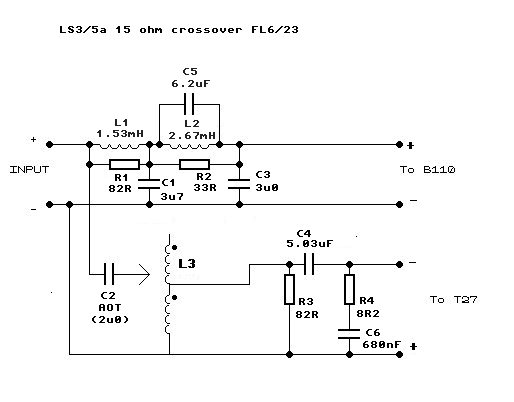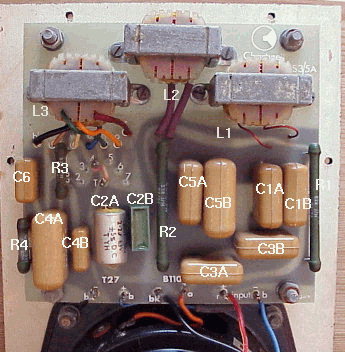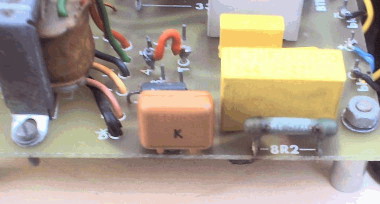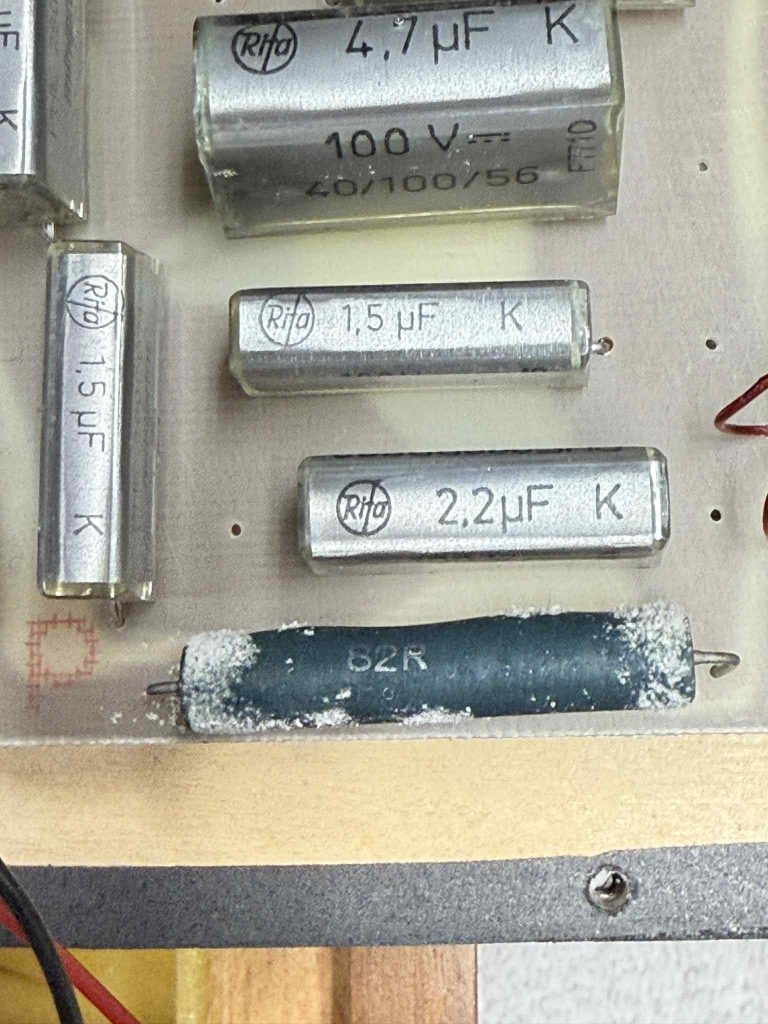The 15 Ohm Crossover
The 15 ohm version crossover boards were made by the manufacturers themselves or by a sub contactor and so differ in appearance but not in their circuit. Over the years, as the specification of the T27 and B110 drive units drifted minor revisions were made to component values to compensate.
1980. C5 was changed to 8.3uF
1984. C5 changed to 10uF and R2 to 22R
The LS3/5A FL6/23 crossover changes have been well documented on the Falcon Acoustics web site.


This FL6/23 crossover shown was made by Chartwell. At this point in manufacture the licensees made up their own crossovers or bought them in from sub contractors like Falcon Acoustics and so variation in printed circuit board colour and layout is seen.
The response of the B110 is equalised by the 1.53mH inductor and 82R resistor. The 6.2uF capacitor, 2.67mH inductor and 33R resistor compensate for the hump in this characteristic. The crossover frequency is 3kHz. L3 operates as a shunt inductor for the T27 tweeter and is adjustable to allow matching of different sensitivity T27 and B110 units. The usual tap position is 4 or 5.
Derek Hughes kindly supplied the following information about the value of the tapped inductor, L3:
Overall inductance for the autotransformer = 0.64mH (ground to tap 7)
The other tap values are approximately:
Tap 6 0.5mH
Tap 5 0.38mH
Tap 4 0.3mH (this is also the feed to the output)
Tap 3 0.22mH
Tap 2 0.165mH
Derek also told me that Spendor 15 ohm LS3/5As did not use a tapped inductor because they tightly selected the drive units. I presume then that the Spendor inductor was 0.3mH to ground with the input and output across the top of it.
C2 is adjusted on test to keep the crossover frequency constant. Chartwell suggest a value of 2.0uF for tap position 5 in the Project Symphony instructions but the original BBC designs varied the value depending on the position of the L3 tap:
Tap 2 C2a – 2.2uF (Type 1) C2b – 0.47uF (Type 3)
Tap 3 C2a – 1.0uF (Type 1) C2b – 1.00uF (Type 1)
Tap 4 C2a – 1.5uF (Type 1) C2b – ——
Tap 5 C2a – 1.0uF (Type 1) C2b – 0.22uF (Type 4)
Tap 6 C2a – 0.47uF (Type 3) C2b – 0.47uF (Type 3)
Tap 7 C2a – 0.68uF (Type 2) C2b – ——
C2 to be made up of the above combinations of C2a and C2b in parallel.
Type 1 – Polycarbonate, 63Volt +/-5%
Type 2 – Advance Filmcap 160 Volt +/-5% CTD 15
Type 3 – Advance Filmcap 160 Volt +/-5% CTD 10
Type 4 – Advance Filmcap 160 Volt +/-5% CTR 6
A potential problem with the 15 ohm crossover is that R4 runs hot. Although not affecting all LS3/5As, many of which will not exhibit any problem, examples have been seen where the polyurethane foam on the cabinet wall and nearby crossover capacitors have melted. In extreme cases damage to the HF crossover components can occur if a LS3/5A has been fed with prolonged high level HF energy.


The blue Rogers crossover was removed from a 15 ohm LS3/5A used in a professional studio where muting was not applied during fast tape spooling. The tweeter had gone open circuit and the heat generated had melted nearby capacitors in the HF section of the crossover. Extensive scorching of the PCB is evident.
Sometimes the Welwyn wirewound resistors will exhibit a white deposit. This is caused by a reaction between the vitreous glaze and the atmosphere. The deposit is not electrically conductive and so does not affect the performance of the resistor or LS3/5A. It is nothing to worry about and can be safely ignored.
The exact formulation of the glaze used is not available but it was traditionally made from glass frits containing lead, boron, alkali oxides, and silicates. The salts of these can migrate to the surface of the resistor through micro cracks in the glaze. And in a damp environment may crystallise to form this white, chalky deposit.
If you do want to replace them for aesthetic reasons then the same Welwyn wirewound resistors are fairly easily available.
If wish to try to clean it off, the deposit is considered low toxicity, but you should assume that it may contain traces of lead or other undesirable heavy metals. So work wet. Use a cotton bud and isopropyl alcohol. Do not ingest or rub the deposit into the skin! Do not scrape or sand the deposit unless suitable ventilation is used and a mask is worn. And wash your hands!

Many thanks to AJ McGarry Photography for the photograph.
Replacement and upgrade 15 ohm crossovers can be purchsed from Falcon Acoustics.
